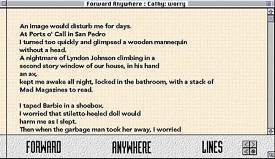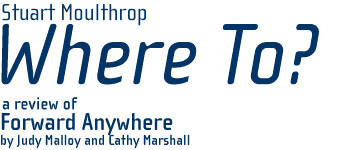Reprinted by permission from
Convergence: The Journal of Research into new media technologies.

Stuart Moulthrop makes hypertexts and teaches design for electronic environments in the Institute for Language, Technology, and Communications Design at the University of Baltimore. He is the author of Victory Garden.
In an essay about their work, the authors of Forward Anywhere thank Mark Bernstein, hypertext impresario and Eastgate Chief Scientist, for arranging the creative matchup. Xerox PARC's artist-in-residence program gets credit, too, for providing initial conditions of the collaboration.
 Both these connections are instructive, reminding us (as if
we could forget) that hypertextual writing occupies a middle space between
the lab and the library, a curious zone where techne seems
momentarily reconciled with "content," inviting us to muse along with
Douglas Coupland's microserfs:
Both these connections are instructive, reminding us (as if
we could forget) that hypertextual writing occupies a middle space between
the lab and the library, a curious zone where techne seems
momentarily reconciled with "content," inviting us to muse along with
Douglas Coupland's microserfs:
What is the search for the next great compelling application but a search for human identity? (15)
We may well wonder. As makers of anything virtual will tell you, middle spaces and interstices are fragile things, apt to buckle at the slightest touch of the reality principle. Imagination will only take you so far in this business; the rest is, well, business. These days most people engaged with information technology concern themselves less with visions of human identity than with social impact and economic productivity. Witness Thomas K. Landauer's enormously important book, The Trouble With Computers, wherein serious questions are raised about the practical value of hypertext and other things digital. This from the man who helped design Superbook, the only hypertext system that is demonstrably more effective than print. Unfortunately, Superbook seems to be an exception. According to Landauer most large enterprises have accepted information technology much in the way Coupland suggests, as an object of existential desire. They would have done better to put their money in the bond market. Things are looking a little stressful down in the lab.
|
Meanwhile back at the library, reciprocal trouble is brewing |
This is not an easy question to handle even on a good day, but happily Judy Malloy and Cathy Marshall have provided a comeback as snappy as it is deep: Forward anywhere! -- or to paraphrase Mr. Roethke and the mathematicians of chaos, we learn by going where we have to go. Unlike the (delusional) journey back to the world of books, an honest commitment to the future permits no foreknowledge of the destination. Solvitur ambulando. We'll know where we're going when we get there.
|
Judy Malloy and Cathy Marshall know things about hypertext that can only come from very strong engagement |
An image would disturb me for days.
At Ports o' Call in San Pedro
I turned too quickly and glimpsed a wooden mannequin
without a head.
A nightmare of Lyndon Johnson climbing in a
second story window of our house, in his hand
an ax,
kept me awake all night, locked in the bathroom, with a stack of
Mad Magazines to read.
I taped Barbie in a shoebox.
I worried that stiletto-heeled doll would
harm me as I slept.
Then when the garbage man took her away, I worried
that she wouldn't have anything to wear
there in her shoebox.
Or for those who don't feel especially nostalgic about Mad, LBJ, or evil fetish dolls, there is this from Judy Malloy:
Every morning, I walked to school very slowly
along the tracks,
in the opposite direction from Boston.
In the evening, long freight trains distorted the picture on the black
and white TV we were allowed to watch for a few hours if our homework was
finished.
After dark, as I lay under layers of wool blankets, night trains
rattled the storm windows beside my bed. Over and over I
dreamed that I was being chased by a relentless freight train
that was able to follow me no matter in which direction I ran.
These passages show a marked congruence or similarity-in-difference. Both reflect on the self-conceived demons and intimate terrors of awakened imagination. Both might have something to say, if we are inclined to read that way, about female identity in world of mechanism and brutality. Yet each emerges from a particular history and sensibility, Malloy's from the postwar suburbs of Boston, Marshall's from California and the sixties. To pass from one of these moments to the other is to recognize the almost-repetition of emergent or autopoetic pattern, an experience that touches something very deep in the instinctual repertoire, perhaps demonstrating that software does speak to human identity after all.
|
The author is not the only one here with goosebumps. |
Like most Eastgate products, Forward Anywhere consists of a sequential, aggregate text file from which a presentation program makes selections in response to reader choices. The sequential file can be browsed in a word processor (a real boon to critics). I culled these two passages essentially at random from the text file. It wasn't until I saw them together that I realized their mutual resonances. At this point I began to think the two "nightmare" passages must be connected by a hypertext link, so I launched the reading program and made my way to Malloy's screen about the freight trains of yesteryear.
Before going further, however, a few words about the interface. At any given point in Forward Anywhere the reader has a number of options for transition. Certain words in the text serve as departure cues or "words that yield," a term Michael Joyce invented in afternoon. As in that work, the cues here are unmarked and mys terious. The reader does not know if a word will yield unless he is willing to plunge forward anywhere (though a handy reverse button is provided should he change his mind). Alternatively, the reader can touch one of three large buttons at the bottom of the window, "Forward," "Anywhere," or "Lines." The first brings up the next passage in order from the sequential file, the second triggers a random jump through the file, and the third activates a specific link to some other part of the work.

© Eastgate Systems, 1996
Now back to our back-story: I tested each of the button options and most if not all the significant words in Malloy's screen about the trains. There were many links to other screens, mainly screens written by Marshall (this alternation of narrators is prevalent throughout the work). None of the links I followed, however, brought me to Marshall's vignette about LBJ and the headless doll. Recalling that there are many ways to read a hypertext, I next brought up Marshall's screen and tested the options there. Though my explorations were not exhaustive (authors have been known to use prepositions-that-yield, but this reader lacks the patience to investigate), I found no direct path from this screen to Malloy's.
|
As Forward Anywhere brilliantly demonstrates, hypertexts are structured in more dimensions than the line. |
For those less in love with bindings, however, this case of the apparently missing link may tell a different story. As Forward Anywhere brilliantly demonstrates, hypertexts are structured in more dimensions than the line. If a link is not apparent it may be implicit, which is to say practically that a screen not available in a single move may be easily reachable in two or three; and in fact the connection between any two passages is less likely to be a specific circuit than a range of possibilities whose exact extent we may leave undefined. (Michael Joyce on afternoon: "You can't flow this thing. There's no flow chart.") Circulation and uncertainty may count for more than concrete structure.
Understanding this implicit or aleatory design may lead to a different set of expectations for texts and perhaps for the emerging hypertextual culture. The phrase "Forward Anywhere" is also a postal instruction (or imprecation) expressing the desire that a letter follow its addressee throughout her extended travels. Keep trying, it says. Sooner or later the connection will be made, if not in some appointed place, then "anywhere." But of course anywhere is not everywhere. The point of arrival or conjunction does occur eventually, decaying from the possible to the actual; what remains indefinite until this happens is the shape of the space between (Joyce's "contour"), or to return to the postal metaphor, the number of intervening postmarks, rain splashes, coffee stains.
|
This is a work that moves and moves with us, an |
Forward Anywhere demonstrates a remarkable commitment to exploration and experiment, a futurity that moves through the past but is not doomed to repetition. This is a work that moves and moves with us, an "open" work in the best sense. In this respect it promises much both in itself and for the sort of writing it represents. However, the leap here is necessarily blind; the story is far from finished. As Judy Malloy says: "Closure was never a goal of this piece."


